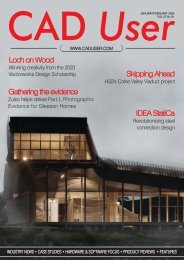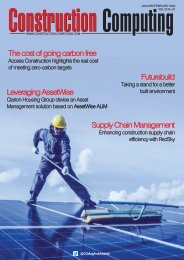DM May-Jun 2023
You also want an ePaper? Increase the reach of your titles
YUMPU automatically turns print PDFs into web optimized ePapers that Google loves.
TECHNOLOGY: DIGITAL ASSET MANAGEMENT Dm<br />
"WITHIN AN ORGANISATION, NO TWO PEOPLE WILL UTILISE CONTENT IN THE SAME WAY, NOR WILL THEY NEED TO<br />
ACCESS THE SAME CONTENT. THIS HAS TO BE REFLECTED IN THE SOFTWARE AND PROCESSES THAT ARE INTEGRATED<br />
INTO A COMPANY'S WORKINGS. OUTDATED LEGACY DAM PRODUCTS PROVIDE LIMITED ORGANISATION TECHNIQUES.<br />
THESE SYSTEMS WORK, BUT DON'T PROMOTE OPTIMAL RESULTS AND WILL OFTEN NOT SCALE WITH THE BUSINESS."<br />
problems within that specific team, being<br />
limited to one functional area can also<br />
create a new challenge. For example, if the<br />
marketing department within an<br />
organisation launches a new product, they<br />
will create material specifically for that<br />
campaign. If the content is stored in their<br />
specific system or shared only over email,<br />
there is a risk that nobody else in the<br />
organisation will know where it is stored.<br />
Or worse still - they won't know that it<br />
even exists.<br />
If another department then does<br />
produce work on the same product, they<br />
will waste valuable time looking for the<br />
content, and likely will be unaware of its<br />
location. Alternatively, they spend time<br />
creating the same content without<br />
knowing it already exists, which is an<br />
inefficient way of working.<br />
This unproductive working method can<br />
also drive teams to create their own<br />
processes to manage the content they<br />
deem most valuable. This creates silos and<br />
renders the purchased DAM futile. It can<br />
also cause security risks, especially if any<br />
unsanctioned tools are used. These data<br />
and content silos not only make it difficult<br />
for the organisation to work proficiently,<br />
but they also create preventable costs<br />
through unnecessary duplication.<br />
Silos can even demotivate employees.<br />
Those who want to become creators<br />
themselves will be slowed down and<br />
discouraged by the inefficient way of<br />
working. Employees who share their work<br />
through social media platforms are<br />
valuable to the company, its products, and<br />
its services. The desire to become a creator<br />
needs to be nurtured, not stifled.<br />
Ultimately, searching for files is not the<br />
best use of an employee's time. Creative<br />
teams often waste hours searching for<br />
necessary materials in isolated folders,<br />
when they could be doing much more<br />
valuable work. DAM has emerged as a<br />
critical solution for eliminating search<br />
fatigue by enabling the company to<br />
store multiple creative assets in one<br />
searchable location.<br />
MORE THAN LOGOS & IMAGES<br />
The move from text to image and then to<br />
video is a great example of how to<br />
comprehend the evolution of media within<br />
the last few decades. Although text and<br />
images previously dominated, within<br />
recent years video has become the most<br />
popular form of content. It's now the goto<br />
method for conveying a message.<br />
Whether in the form of a quick Instagram<br />
story to make an announcement, a<br />
product demonstration, or a customer<br />
testimonial; all of these are frequently in<br />
video form and used as a quick and visual<br />
way to communicate with audiences.<br />
The exponential demand for digital<br />
content is fuelled by the expanding uses of<br />
rich media assets. These assets are no<br />
longer just for the purview of marketing<br />
teams and their consumers. Video<br />
messages are distributed internally<br />
throughout a multitude of organisations.<br />
These messages generate a more<br />
personalised experience to employees,<br />
helping to deliver the company's key<br />
messaging or provide health and safety<br />
training, for example. This means everyone<br />
in the business is aware of the<br />
organisation's messaging, and key values -<br />
and can be a brand ambassador for them.<br />
Despite the rise of video as a tool to<br />
educate and inform, older management<br />
systems are failing to keep up with the<br />
pace of change. Legacy brand<br />
management systems used during the<br />
time of logo and image domination are<br />
now completely overwhelmed when<br />
processing and organising large volumes<br />
of video files. The diversification of content<br />
requires solutions that can quickly and<br />
effectively manage a large quantity of<br />
media in various formats.<br />
INTEGRATION IS KEY<br />
DAM systems generally have an<br />
integrated solution, where it interacts<br />
with other applications rather than just<br />
providing the expected basic functions.<br />
This allows for media assets to be easily<br />
located when needed and enhances<br />
collaboration by authorising information<br />
to be pulled from other applications. It<br />
provides functionalities for content<br />
creation in addition to the workflow<br />
management tools.<br />
Some DAM systems operate as a<br />
platform, creating a foundation for<br />
building solutions and systems. Platforms<br />
permit multiple products, applications or<br />
integrated approaches to be built within<br />
the same technical framework. This fosters<br />
a streamlined and wider-ranging<br />
integration experience for processes and<br />
applications across an organisation. When<br />
determining the appropriate platform for<br />
an organisation, it is important to think of<br />
it not just as a technical solution, but as a<br />
business framework.<br />
When considering the integration of a<br />
DAM system, the longevity of the platform<br />
should be paramount. While video is still<br />
king of content, it's rise to the top only<br />
goes to show how quickly things can<br />
change. And how unprepared the<br />
outdated systems can be for this shift.<br />
Open-source DAM platforms, which<br />
provide increased scalability, will allow for<br />
growth and change. When you add new<br />
assets to the platform, you can create new<br />
features to enable user to discover and<br />
protect those files. Features such as this are<br />
critical to the lifespan of a platform. With<br />
the amount of content increasing and<br />
becoming more complex, you need a<br />
system that will support company growth<br />
and not hinder it.<br />
More info: www.hyland.com<br />
www.document-manager.com<br />
<strong>May</strong>/<strong>Jun</strong>e <strong>2023</strong><br />
@<strong>DM</strong>MagAndAwards<br />
19

















